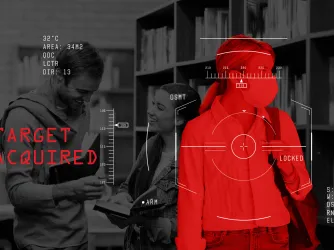Table of Contents
‘Speaking Freely’: Self-expression in the classroom and on campus

This is the first installment in a series of posts delving into the results of FIRE’s "Speaking Freely" report on college students’ attitudes toward expression on American campuses. In this post, we will talk about the first section of our report, which focuses on students’ comfort in expressing opinions on their campus. Next week we will explore the partisan and ideological divides toward expression on campus.
In a previous post discussing the larger area of research into which FIRE’s "Speaking Freely" report fits, we noted that students’ attitudes toward expression on campus were analyzed in the 2011 book, “The Still Divided Academy” by Stanley Rothman, April Kelly-Woessner, and Matthew Woessner. Although the results in their book are not directly comparable to our survey’s results due to differences in question wording, Rothman and his coauthors had similar results to ours and drew complimentary conclusions.
The survey data analyzed in “The Still Divided Academy” included questions on self-expression, which were asked of 1,466 college students. Students responded to the following two questions: (1) “How often, if at all, did the student respondent avoid expressing any particular points of view because of a negative reaction from faculty?” (2) “How often, if at all, did the student respondent avoid expressing any particular points of view because of a negative reaction from other students?”
Our questions were slightly different. We asked students how strongly they agreed or disagreed with the following statements: (1) “In my college classes, I have stopped myself from sharing my ideas and opinions,” and (2) “When I spend time on campus outside of my classes, I have stopped myself from sharing my ideas or opinions.” If students agreed or strongly agreed with one of these statements, we provided them a list of reasons why they may have stopped themselves from sharing. The list included options such as “I thought I would offend my classmates,” and “I thought the professor would disagree with me.” Students were able to select as many reasons as applied to their situation. Like Rothman et al., we made sure to include reasons for self-censorship that may originate from professors or other students.
Rothman and his co-authors’ findings on student expression are discussed in depth in Chapter 6 of the “The Still Divided Academy,” but we will highlight two findings here. First, the authors found that “[students] are more likely to withhold opinions because of other students’ reactions than they are because of faculty reactions.”
In our survey results, we find additional support for Rothman et al.’s finding that students are more likely to stop themselves from expressing opinions because of a negative reaction from other students than because of a negative reaction from faculty. We find the following:
- Forty-eight percent of students might self-censor in the classroom because another student might judge them;
- Thirty percent of students might self-censor in the classroom because they might offend another student;
- Twenty-seven percent of students might self-censor in the classroom because the professor might disagree with them;
- Twenty-one percent of students might self-censor in the classroom because the professor might give them a lower grade.
We find similar results when students are on campus, but outside of the classroom, with more than thirty percent of students self-censoring because another person might find what they say to be politically incorrect, because they might hurt another person’s feelings, or because they might be judged by another person.
Rothman and his coauthors write that students may be more likely to avoid expressing a point of view when interacting with students than when interacting with professors because “students have greater interaction and more conversations with other students, so the frequency of self-censoring may be a function of the number of opportunities for disagreement.” The more times students interact with each other, the more opportunities they have both to express their points of view, and to stop themselves from sharing. We agree, and reported that “it makes sense that students who have spent more time on campus will have had more opportunities to express an idea or opinion — and to stop themselves from expressing an idea or opinion.”
Rothman et al. also found that “students do not differ in their willingness to express opinions according to party affiliation.” Our results diverge slightly from the results discussed in “The Still Divided Academy,” but this may be because their sample was surveyed more than fifteen years before ours, or because of the differences in question wording.
Both inside and outside of the classroom, we find that “[Democratic students] are slightly more comfortable sharing their opinions in the classroom than [Republican students].” Our results show that the Democratic students are only seven to nine percentage points more comfortable than their Republican peers, which is only slightly more than the two percentage point difference reported by Rothman et al.
The margin of error for our survey — which is discussed in more depth in our survey FAQ — indicates that this difference between Democrats and Republicans could actually be even smaller than seven to nine percentage points, bringing it more closely in line with Rothman and his coauthors’ findings. Alternatively, the margin of error for our survey could indicate that the difference in comfort felt by students of different partisanships could be larger, with Democrats feeling even more comfortable expressing their opinions on campus than their Republican peers.
No matter how small it may be, the emergence of a partisan divide in how comfortable college students feel expressing opinions on campus is something that we believe deserves more research.
We are encouraged to know that the findings in our report are in many ways consistent with those discussed in “The Still Divided Academy,” even though our questions were not worded exactly the same and were asked of students more than fifteen years after the data analyzed in the “The Still Divided Academy” was collected. As we have previously noted, replication is extremely important in social science research, and it is valuable to understand how student attitudes have changed over time.
If you are interested in learning more about how faculty, administrators, and students feel about issues affecting the academy, we encourage you to delve into the pieces we highlighted in our previous review. We hope you check back next week to learn about partisan and ideological divides among college students.
Recent Articles
Get the latest free speech news and analysis from FIRE.

Will free expression make a comeback at Haverford College?

FIRE statement on FCC approval of Skydance-Paramount acquisition

The mercenary spyware industry is a menace to global free expression
